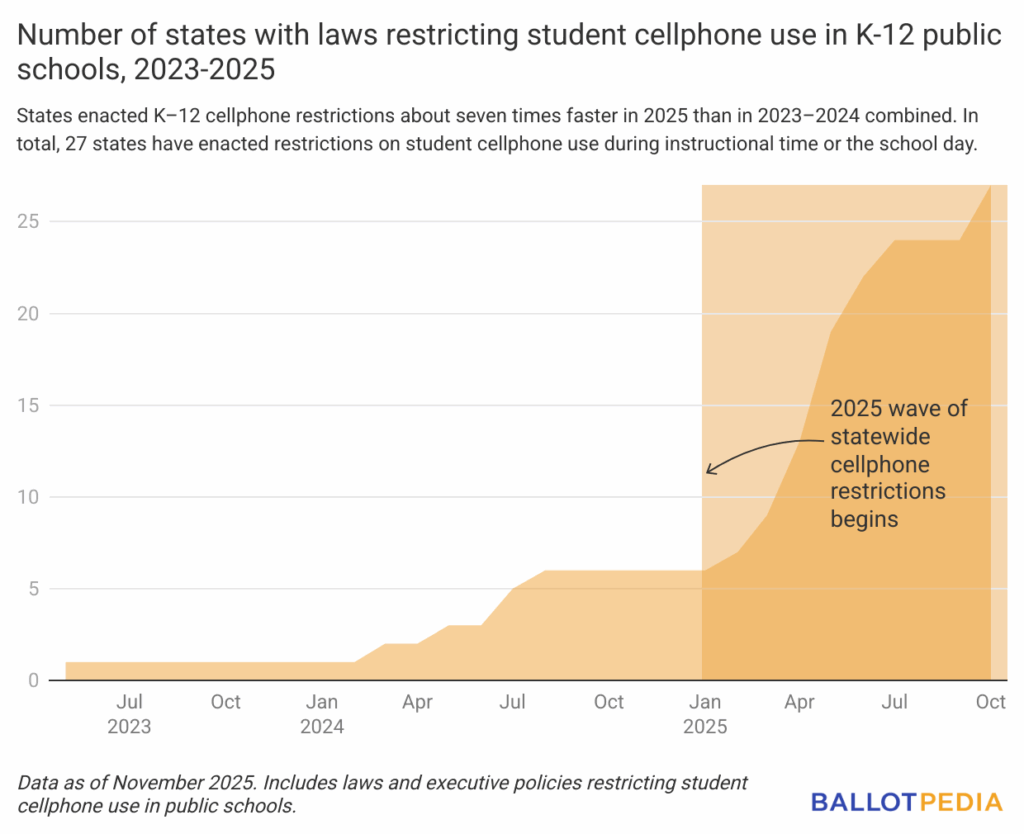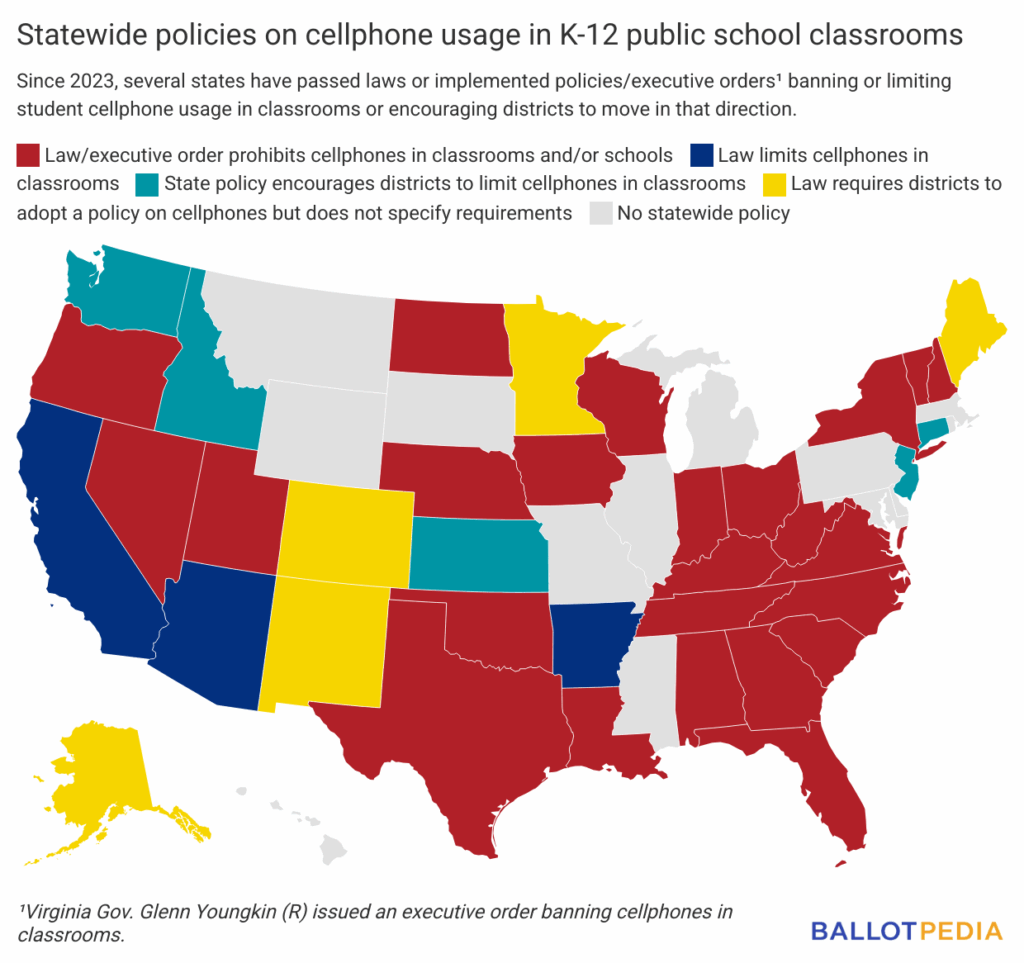Welcome to the Thursday, Nov. 13, 2025, Brew.
By: Lara Bonatesta
Here’s what’s in store for you as you start your day:
- Wisconsin becomes the 21st state to adopt a K-12 cellphone ban in 2025
- Alaskans could decide on their third ranked-choice voting ballot measure since 2020
- This week On The Ballot: the Senate deal that will end the shutdown and fund the federal government through January 30
Wisconsin becomes the 21st state to adopt a K-12 cellphone ban in 2025
A version of this story appeared in Hall Pass, Ballotpedia’s newsletter dedicated to school board politics and education policy on Nov. 12. Click here to sign up.
On Oct. 31, Wisconsin Gov. Tony Evers (D) signed Assembly Bill 2 requiring school boards to adopt policies to prohibit cellphone use during instructional time.
The Wisconsin Assembly passed the bill 53-45 on Feb. 19 with mostly Republican support. Fifty-three Republicans voted in favor. One Republican and 44 Democrats voted against it. On Oct. 14, the Wisconsin Senate passed the bill 29-4. Eighteen Republicans and 11 Democrats were in favor, and four Democrats were opposed.
Wisconsin has a divided government. Republicans have a 54-45 majority in the state Assembly and an 18-15 majority in the state Senate. Evers is a Democrat.
Between May 2023 and the end of 2024, six states enacted statewide restrictions on student cellphone use in schools—an average of roughly one every three months. Since the beginning of 2025, an average of roughly two states have enacted restrictions each month.
Arkansas was the first state to adopt a cell phone ban in 2025, when Gov. Sarah Huckabee Sanders (R) signed SB 142 on Feb. 21. Before Wisconsin, the last state to limit cellphones in public schools was Oregon. Oregon Gov. Tina Kotek (D) issued an executive order on July 2 prohibiting student cellphone use during the school day.

Thirty-six states have laws or policies addressing cellphone use in schools since 2023, but not all of them require districts to limit the technology.

Of the 27 states that have required districts to restrict student cellphone access in schools:
- Seventeen have Republican trifectas.
- Three have Democratic trifectas.
- Six have divided governments
In the six states with divided governments, four have Democratic governors—Arizona, Kentucky, North Carolina, and Wisconsin—and two—Nevada and Vermont—have Republican governors.
California and New York, two of the three Democratic trifectas with cell phone restrictions, account for 8.5 million (17%) of the country’s 50,000,000 K-12 public school students, according to the National Center for Education Statistics. California enacted its law in September 2024. New York adopted its ban in May, when the government enacted the Fiscal Year 2026 budget.
Of the seven states whose legislatures are still in session, at least two are considering bills that would restrict student cellphone use in K-12 public schools:
- Massachusetts: On July 31, the Massachusetts Senate passed SB 2581 38-2. The bill would require districts to enact policies banning student cellphone use during the school day, with exceptions for, among other things, students with disabilities and medical conditions. The bill is now pending before the House Ways and Means Committee. Massachusetts has a Democratic trifecta.
- Pennsylvania: State Sens. Devlin Robinson (R), Vince Hughes (D), and Steve Santarsiero (D) introduced SB 1014 on Oct. 10. The bill would require districts to prohibit students from using their cellphones during the school day, with exceptions similar to those in the Massachusetts bill. The Senate Education Committee held a hearing on the bill on Oct. 23. Pennsylvania has a divided government.
Click here to learn more about state-level policies on cellphones in schools.
Alaskans could decide on their third ranked-choice voting ballot measure since 2020
In Alaska, Repeal Now, an organization supporting an effort to repeal the state's ranked-choice voting system, submitted 48,000 signatures to the Division of Elections on Nov. 6. At least 34,098 signatures must be found valid for the measure to appear on the ballot in 2026.
Alaska’s RCV system combines top-four primaries with ranked-choice voting in general elections. Voters established the system when they approved Ballot Measure 2 50.6%-49.5% in 2020.
The initiative would also repeal Ballot Measure 2’s campaign finance disclosure provisions, which require individuals and entities that contribute more than $2,000 per year from funds that were derived from donations, contributions, dues, or gifts to disclose the original, or true sources of the contributions. The initiative defined true sources as individuals and entities whose contributions are derived from wages, investment income, inheritance, or revenue from selling goods or services.
If the measure qualifies for the ballot, it would be the second time voters have considered a proposal to repeal RCV in Alaska. The first was in 2024, when voters defeated a ballot measure, also titled Measure 2, 50.1%-49.9%.
Eight states, including Alaska, authorize or require RCV for certain elections. Seventeen states prohibit or restrict RCV. Maine and Alaska are the only states to use RCV in statewide elections. Hawaii also uses RCV in special congressional elections.
In Alaska, an initiative is not officially certified for the ballot until after "a legislative session has convened and adjourned." This gives the Legislature time to consider the proposal or similar legislation. According to state law, the initiative is voided when “an act of the legislature that is substantially the same as the proposed law was enacted after the petition had been filed, and before the date of the election." Otherwise, the initiative is certified to appear on the ballot for the first statewide election 120 days after the Legislature's adjournment.
One ballot initiative has qualified for the 2026 ballot in Alaska. It would establish campaign contribution limits for state and local offices. Two other campaigns are collecting signatures. Signatures must be submitted before the start of the legislative session, which begins Jan. 20, 2026.
Click here to learn more about the proposed initiative in Alaska.
This week On The Ballot: the Senate deal that will end the shutdown and fund the federal government through January 30
In this week’s new episode of On The Ballot, Axios reporter Hans Nichols joins host Norm Leahy to discuss the Senate’s Nov. 10 move to advance legislation that would end the federal government shutdown.
The Senate voted to invoke cloture on and pass a modified version of the Republican-sponsored continuing resolution. The vote was 60-40. Seven Democrats and one Independent who caucuses with Democrats joined 52 Republicans voting in favor. The resolution would fund the government through January 30.
Nichols discusses what happens next in the House, what the deal means for SNAP benefits and ACA tax credits, and how this may affect each party politically in the weeks ahead.
On Nov. 12, Adelita Grijalva (D), who was elected on Sept. 23, was sworn in. Media outlets reported that the House was scheduled to start voting on the continuing resolution shortly after. As of this writing, the House had not yet voted on the funding bill.
Click here to listen to the episode and here to read more about the federal government shutdown.

